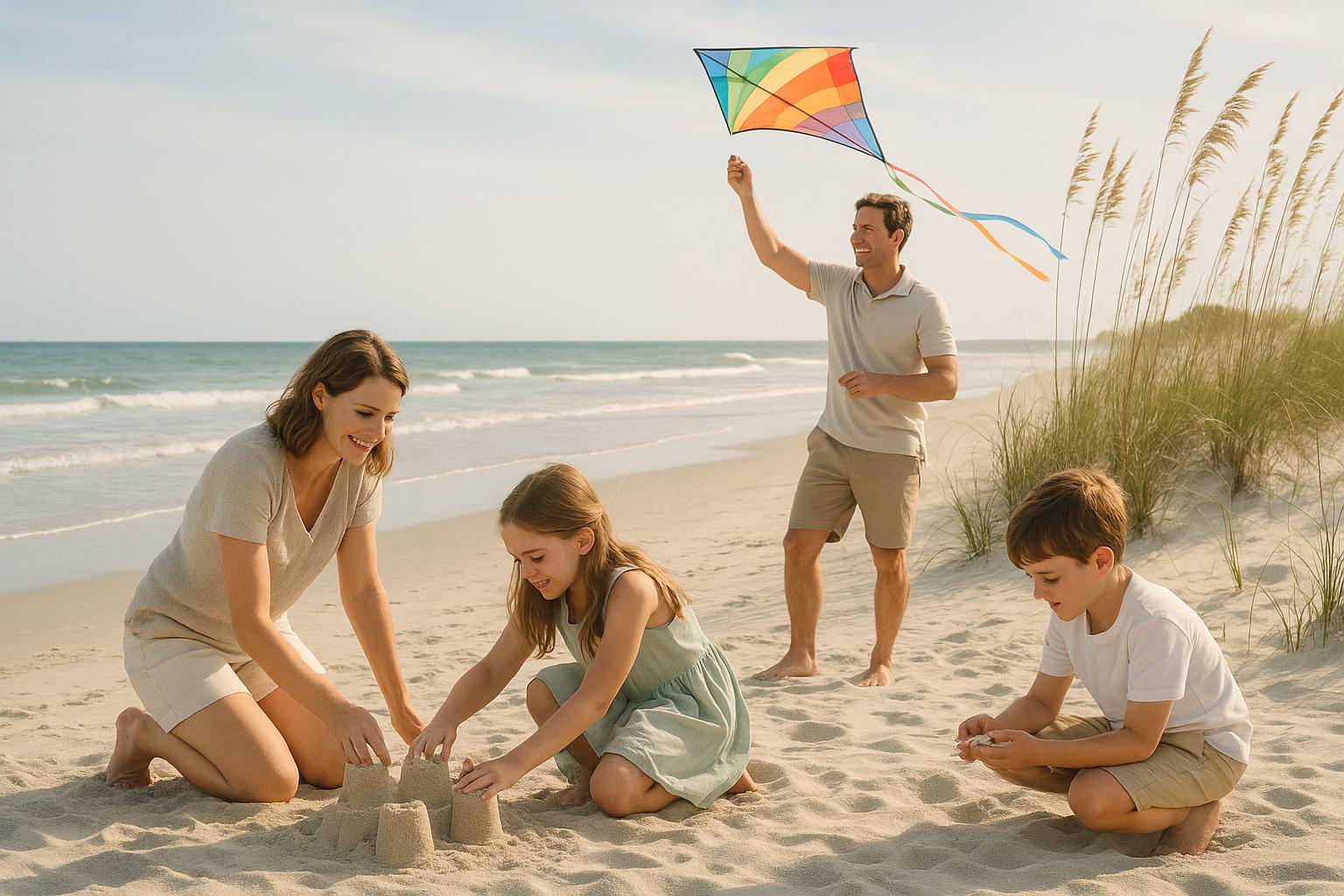How to Plan a Group Beach Vacation: Essential Tips
- March 18, 2025
Planning a group beach vacation can be fun but also challenging. Here’s a quick guide to make it easier:
- Start Early: Book accommodations and flights 6–12 months in advance, especially for summer trips.
- Pick the Right Destination: Choose a beach that’s easy to reach, has group-friendly amenities, and offers activities for all interests. Example: Isle of Palms, SC.
- Book Group-Friendly Stays: Look for rentals with enough bedrooms, bathrooms, and shared spaces. Features like kitchens, pools, and proximity to the beach are a plus.
- Set a Budget: Use tools like spreadsheets or apps to plan and split expenses fairly. Apps like Splitwise or Venmo simplify cost-sharing.
- Balance Activities: Mix group activities with downtime. Let everyone rank their must-do plans to ensure variety.
- Communicate Clearly: Use shared tools (like group chats or apps) to organize plans and keep everyone informed.
- Be Flexible: Allow for changes and personal space to keep the trip stress-free.
How to Plan the Perfect Beach Vacation – 5 Tips for Anyone
Picking the Right Beach Destination
The beach you choose can make or break your trip, especially when traveling with a group. A bad pick might lead to frustration and wasted money, while the right one creates unforgettable memories.
What to Consider When Picking a Destination
Look for destinations that are easy to reach. Direct flights, reasonable driving distances, and convenient local transportation options like shuttles or bike rentals can reduce travel stress and make the journey smoother. The vibe of the destination also matters – whether you’re planning a family getaway, a trip with college friends, or a corporate retreat, the atmosphere should suit your group. For example, a party-heavy beach might not be the best fit for a multi-generational family reunion.
Isle of Palms, South Carolina is a great example of a group-friendly beach destination. It offers sandy shores, excellent fishing spots, opportunities to explore nature, and is just a short drive from Charleston. This mix of relaxation and adventure makes it appealing to travelers with different interests.
Once you’ve narrowed down your options, it’s time to focus on what the destination offers to enhance your experience.
Finding Amenities and Activities
Comfort and convenience are key. Beaches with basic facilities like restrooms, water fountains, and concessions make the trip easier. Rentals for chairs or umbrellas are a bonus. Safety is also crucial – opt for beaches with lifeguards on duty and access to medical facilities. Avoid areas with known hazards like strong currents or algae blooms.
Food is another important factor. Look for places with a variety of dining options that cater to different tastes and dietary needs. Accommodations with full kitchens can also be a win, giving you the flexibility to cook meals together and enjoy some quality bonding time.
Activities can take your trip to the next level. Whether it’s kayaking, paddleboarding, fishing charters, or dolphin tours, having options ensures there’s something for everyone. For families, attractions like mini golf, aquariums, or nature centers are great alternatives, especially if the weather takes a turn.
Finding Privacy and Convenience
A good destination strikes a balance between seclusion and accessibility. Rentals close to the beach or within walking distance of attractions add convenience. Look for features like multiple master suites, kid-friendly amenities, and accessibility options to accommodate everyone in your group.
It’s also smart to plan for bad weather. Beaches near indoor attractions – like marine parks, science centers, or shopping areas – help keep everyone entertained, rain or shine.
Once you’ve picked the perfect destination, the next step is finding accommodations that suit your group’s needs.
Booking Accommodations for Groups
When planning a group trip, it’s important to find accommodations that encourage togetherness while still giving everyone their own space. Once you’ve outlined the general criteria, the next step is figuring out what specific features your group needs.
Finding Properties That Work for Groups
Look for properties that offer plenty of bedrooms and bathrooms – ideally, one bathroom for every two bedrooms. Spacious common areas, like large living rooms and dining spaces that can seat everyone comfortably, are ideal for shared meals and evening gatherings.
For beach trips, outdoor amenities can make a big difference. Think private pools, outdoor kitchens, and roomy decks where everyone can relax after a day in the sand. Take the Aerie at 715 Ocean in Isle of Palms, for example. This property boasts a private pool, an outdoor kitchen with showers, and enough space to host up to 16 guests. Plus, it offers golf cart rentals, making it easy to explore the island together.
A fully equipped kitchen is another must-have. It allows you to prepare meals as a group and save on dining costs. Look for features like large refrigerators, multiple cooking surfaces, and enough cookware and dishes for everyone.
Entertainment options can add to the fun. Properties with smart TVs, game rooms, and high-speed WiFi ensure there’s something for everyone – whether it’s streaming a movie, playing games, or catching up on work.
Once you’ve identified these features, tailor your search to match your group’s specific needs.
Figuring Out What Your Group Needs
Start by gathering input from everyone in the group. Note any non-negotiables, like accessibility features, pet policies, or must-have amenities such as a hot tub.
If you’re traveling with older family members or guests with mobility issues, accessibility features are crucial. Look for properties with elevators, ramps, minimal stairs, ground-floor bedrooms, and accessible bathrooms.
For families with young children, kid-friendly amenities should be a priority. Safe play areas, baby gear, and childproofed spaces can make a big difference. Some properties even provide extras like cribs, high chairs, or beach toys.
Privacy is another factor to consider. Multi-generational families might prefer properties with separate wings or floors, while groups of friends may enjoy staying closer together. Striking a balance between communal and private spaces is key to keeping everyone happy.
Finally, think about location. Proximity to key attractions like beaches, restaurants, shops, and activities can save time and make the trip more enjoyable. Choose a property that aligns with your group’s planned activities and priorities.
When and How to Book
Once you’ve identified your group’s needs and the features you want in a property, it’s time to book. Early planning is essential to secure the best options. For summer beach trips, aim to book 6 months to a year in advance. For spring and fall trips, 3–6 months is usually sufficient, while winter travel often allows for bookings just 1–3 months ahead.
“During the busy summer travel season, most travelers book at least 7 to 13 days out for domestic travel and 90 days out for international travel.”
– Melanie Fish, Vice President of Global Public Relations for Expedia Brands
If your travel dates are flexible, you might save big. Booking within a week of domestic summer travel, for example, can lead to savings of around 35%. However, this strategy comes with the risk of limited availability.
Direct booking often provides the best value and service. Many properties will match third-party rates and include perks like flexible cancellation policies, early check-in, or complimentary extras. When booking directly, mention your group’s size and potential for repeat business to negotiate group discounts.
“Hotels often match third-party rates while offering additional benefits like flexible cancellation policies or free breakfast.”
– Coleen Gomez, Travel Advisor
If your travel dates are set in stone, prepaid, non-refundable rates can save you 10–15%. Just make sure your plans are final before opting for this choice.
For longer stays, ask about extended-stay discounts, which often kick in after five days. Many properties also offer package deals that include extras like shuttle services, meals, or room upgrades. Always inquire about the full package to get the most value for your money.
With your accommodations locked in, you’re ready to tackle the next step: managing the financial details of your group trip.
Managing Money and Expenses
Careful financial planning can make or break a group vacation. Getting ahead of potential money stress with smart strategies ensures a smoother experience for everyone.
Making a Complete Budget
Start by breaking down your expenses into categories like accommodation, transportation (flights, gas, or parking), food and drinks, activities, and miscellaneous costs – think souvenirs or emergency funds.
Take time to estimate each cost. For example, check current airfare prices and factor in possible increases. When it comes to meals, your budget will depend on whether you’re dining out often or cooking at your rental.
Using a spreadsheet can help you stay organized. Create columns for each category, include formulas to calculate totals, and track how much of your budget is left. Consider drafting two budgets: a basic one for essentials and a more flexible one for extras like upscale dining or premium activities.
Once your budget is set, focus on splitting costs in a way that works for everyone.
How to Split Costs Fairly
Dividing expenses fairly starts with open conversations about what everyone is comfortable spending. As Sarah Foster, an analyst and economy reporter at Bankrate, puts it:
“A lot of the challenges that people face when committing to travel or going places with their friends can be fixed with the general idea of being comfortable talking about money.”
There are a few ways to approach splitting costs. You could divide shared expenses evenly, let individuals cover their own purchases as they go, or take turns paying for group activities in a round-robin style. For accommodations, decide whether splitting by room or by person makes the most sense.
Apps like Splitwise or Venmo can make tracking and managing payments much easier. In fact, PayPal‘s Venmo processed about $60.6 billion in payments during the fourth quarter of 2021, reflecting a 29% year-over-year growth.
Another option is to set up a shared fund where everyone contributes upfront for group expenses like taxi rides or tickets. As Jennifer Gray, a licensed professional counselor, advises:
“From the start, do your best to set a standard of kindness, respect, and openness. Money is a tricky topic, and you want to make sure that no one feels picked on, even if it’s unintentional.”
Once costs are divided, keep an eye out for fees that can sneak up on you.
Watching Out for Hidden Costs
Hidden fees can quickly derail your budget if you’re not careful. For instance, resort fees average around $42.41 per night, which is about 11% of a single night’s stay, according to a January 2023 NerdWallet analysis of 100 U.S. hotels. Other common hidden costs include parking fees, tourist taxes (usually $1 to $5 per person per night), airline seat selection fees (ranging from $5 to over $100 per flight), and baggage fees.
Vacation rentals often come with additional charges like cleaning fees, service fees, and local taxes. Always review the full cost breakdown before confirming a booking.
To stay ahead of surprises, set aside a contingency fund for unplanned expenses and research tipping customs for your destination. By thoroughly reviewing terms and doing your homework, you can avoid unexpected fees and keep your trip running smoothly. This preparation ties back to the detailed budgeting and cost-sharing strategies you’ve already established.
sbb-itb-af832cd
Planning Activities Everyone Will Enjoy
Once you’ve sorted out lodging and budgets, it’s time to focus on planning activities that will keep everyone in the group engaged. A well-thought-out itinerary should strike the right balance between group activities, personal downtime, and room for spontaneity.
Making a Flexible Schedule
Overloading the schedule is a common mistake. Keep it simple and stick to no more than two planned activities per day. This leaves room for those unexpected moments – like stumbling upon a hidden gem – that often become the highlights of a trip.
A great starting point is having everyone rank potential activities into three categories: “must-see”, “want to see”, and “if time allows.” Elizabeth Yuko suggests:
“Have everyone rank activities as ‘must-see,’ ‘want to see,’ or ‘if time allows’ to ensure top attractions are included.”
Don’t underestimate the importance of downtime. Build in free time for things like lounging by the water, savoring a slow meal, or just wandering at your own pace. Some group members might want to take a nap after lunch, while others could prefer a beach walk or reading under an umbrella.
To keep things running smoothly, review the next day’s plans together each evening. This helps everyone stay informed and allows for last-minute tweaks based on weather, energy levels, or new discoveries.
Including Different Interests
Catering to everyone’s interests is key to a memorable trip. Think about hobbies, physical abilities, dietary needs, and budget preferences. A well-rounded beach vacation might include water sports, local exploration, dining experiences, and plenty of relaxation.
For groups with varying energy levels, consider splitting up activities. Some might enjoy high-energy options like jet skiing, while others may prefer a laid-back cultural tour or a quiet afternoon by the shore. Plan to reconnect over meals or evening events to keep the group dynamic intact.
When traveling with multiple generations, look for activities that suit all ages. Mini golf, nature walks, or casual games like beach volleyball can work for everyone. If you’re traveling with kids, let them take turns choosing a day’s activities – it’s a fun way to keep them engaged and excited.
For friend groups or colleagues, team-building activities can add a fun twist. Options like group yoga on the beach, volunteering for a local cause, or tackling an aerial park together can help strengthen bonds.
Using Planning Tools to Stay Organized
Travel apps can make group planning a breeze. For example, Wanderlog is great for organizing itineraries, tracking expenses, and mapping out attractions.
If you’re looking for something tailored to group travel, SquadTrip might be the perfect fit. It combines payment collection, itinerary building, and expense tracking all in one place. As their team puts it:
“SquadTrip isn’t just a trip planner app – it’s a group travel planner that brings everything into one place so you can skip the hassle and enjoy the travel experience.”
Another option is Let’s Jetty, which organizes all trip details in one streamlined itinerary planner. Many of these tools also include shared calendars, group chat features, and polling options for making decisions.
The trick is to pick one tool and make sure everyone uses it consistently. Send friendly reminders to check the app for updates, and designate an “activity coordinator” to keep everything organized and answer questions. By integrating these tools with your overall budget and schedule, you’ll simplify the entire trip-planning process.
Tips for a Smooth Group Experience
Even the best-planned beach trips can hit a few snags. To keep things running smoothly, focus on clear communication, respect personal boundaries, and tackle conflicts quickly. These steps can help your group stay connected while ensuring everyone has the freedom to enjoy the trip their way.
Setting Up Clear Communication
Start planning early by creating a single group chat or shared platform where everyone can stay in the loop. Assign specific roles – like managing reservations, organizing transportation, or researching local activities – to keep things organized. Sharing a simple itinerary ahead of time sets expectations and helps align travel preferences, budgets, and potential challenges.
As communication expert Earl Kennaugh says:
“Communication is essential for any team’s success, but it becomes even more critical when team members work remotely and travel frequently.”
Decide how often the group will check in, what updates need to be shared immediately, and how decisions will be made. A little clarity upfront can save a lot of headaches later.
Balancing Group Time and Personal Space
Not everyone wants to be around others 24/7, and that’s okay. Plan group activities but also leave room for personal downtime. Encourage open conversations about how much alone time each person might need. This balance lets everyone enjoy the trip in a way that works for them.
Breakout groups can also be a game-changer. If some people want to snorkel while others prefer a museum visit, split up temporarily and regroup later for a shared meal. Make space for naps or quiet time – whether you’re traveling with kids or grandparents, everyone benefits from a little rest. And most importantly, don’t pressure anyone into activities they’re not comfortable with.
Handling Disagreements
Even on a well-organized trip, conflicts can pop up. Acknowledge this possibility and agree on how to handle disagreements before they arise. Set ground rules like staying calm, listening respectfully, using “I-statements”, and focusing on solutions. These simple steps can keep discussions productive and respectful.
Relationship expert Isabella Davis reminds us:
“Remember that the purpose of the trip is to have fun and create lasting memories with your friends.”
If an issue comes up, address it quickly and focus on finding a solution rather than assigning blame. Compromises – like alternating between energetic and laid-back activities – can help satisfy everyone. If someone seems upset, check in with them privately to see if they’d like to talk. And don’t underestimate the power of a snack or a quick break – sometimes hunger or stress can make small problems feel bigger than they are. Resolving conflicts promptly helps keep the group dynamic positive and the trip enjoyable.
Conclusion:
Main Points for a Great Group Beach Vacation
Review of Main Planning Tips
Pulling off a fun and stress-free group beach vacation boils down to three essentials: early preparation, clear communication, and staying flexible. Start planning at least a year in advance. This gives you a better shot at locking in great accommodations and allows plenty of time to sort out budgets, preferences, and expectations.
Good communication is the backbone of any group trip. Personal finance expert Stefanie O’Connell Rodriguez highlights this perfectly:
“When doing anything as a group, it’s important to remember that each person is coming in with their own boundaries and expectations around everything from spending to space to time”.
Make sure everyone has a chance to weigh in by setting up clear ways to share information.
To keep things running smoothly, delegate tasks by forming a small leadership team of two or three people. Travel psychologist Michael Brein, PhD, explains:
“Having a leader or even a small committee of two to three [leaders] maximum makes things much easier for everyone”.
One person might handle accommodations, another might organize activities, and someone else could track expenses using apps like Splitwise or Tab.
And don’t forget – flexibility is your best friend when plans change. Schedule a few must-do activities, but leave room for spontaneous fun and downtime so everyone can enjoy the trip their way.
Start Planning Your Trip
Now’s the time to get the ball rolling. Gather your group, decide on a budget, and secure flights and accommodations early.
Looking at Isle of Palms? Vacation rentals here are ideal for large groups, offering perks like spacious kitchens, cozy living areas, and outdoor spaces perfect for relaxing by the beach. Many even come with extras like pools, spas, and elevators.
Travel writer Sophie Friedman shares a great tip for organizing your plans:
“Google Docs and Google spreadsheets are life – especially because everyone can edit them and put in any requirements they have or activities they want to do”.
Set up shared documents, start a group chat, and let the planning begin. Even the process of organizing can be part of the fun.
Every unforgettable group beach vacation starts with a simple conversation about dates and destinations. Use these tips, bring your group together, and start creating memories that will last a lifetime.
FAQs
How can I make sure everyone in the group is happy with the beach destination we choose?
To make sure everyone in your group is excited about the beach destination, start by gathering their input. A quick poll or group chat works wonders for figuring out preferences – whether it’s lounging in the sun, diving into water sports, enjoying nightlife, or even considering travel distance and budget. This simple step helps you choose a spot that ticks all the boxes.
When picking a location, aim for one that offers a variety of accommodations and activities. Look for beaches with serene areas for those who want to unwind and more vibrant spots for those seeking fun and socializing. Keeping plans flexible is another smart move – mix in group activities with plenty of downtime so everyone can tailor the trip to their liking.
How can we manage and split expenses fairly during a group beach vacation?
To make your group beach vacation smooth and budget-friendly, start by talking about expenses ahead of time. Decide how you’ll split costs for things like accommodations, meals, and activities before you even pack your bags. Clear communication helps avoid misunderstandings later.
Using expense-tracking apps can also be a game-changer. Tools like Splitwise let you log shared costs and figure out who owes what in just a few taps. It keeps things organized and eliminates any awkward money conversations during the trip.
When it comes to shared costs like lodging, consider splitting them proportionally. For example, you could divide expenses based on room size or how long each person is staying. This way, everyone contributes fairly, even if their preferences or schedules differ.
How can we plan group activities while still allowing time for personal relaxation on a beach vacation?
To balance group activities with personal downtime, start by having an open conversation about the trip’s goals. Invite everyone to share their thoughts on group outings and the amount of solo time they’d like. This simple step ensures everyone feels included and helps lay the groundwork for a plan that suits the whole group.
One way to achieve this is by creating a flexible itinerary. Mix in planned group activities, such as morning beach games or evening visits to local attractions, with open slots for personal time. These free periods can be used for relaxing, exploring independently, or simply unwinding.
This approach strikes a balance between shared experiences and personal space, making the trip enjoyable for everyone while giving them the chance to recharge in their own way.
Share With:
Latest Article
5 Tips for Booking a Luxury Beach House Rental
•
July 7, 2025
Ultimate Guide to Isle of Palms Vacation Planning
•
June 30, 2025
Beach House vs Hotel: Choosing Your Isle of Palms Stay
•
June 23, 2025
7 Best Family Activities Near Isle of Palms Beach
•
May 21, 2025
Book Your Dream Beach Vacation at 715 Ocean!
Don’t miss the chance to stay at one of Isle of Palms’ most luxurious vacation rentals. From private pools to beach access, Aerie has everything you need for a perfect getaway.
Book Now


